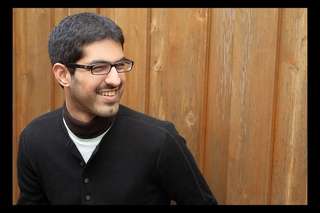|
Back
A masterpiece revealed Toronto
Victoria College Chapel
05/07/2011 -
George Frideric Handel: Il Trionfo del Tempo e del Disinganno
Mireille Asselin (Bellezza), Susanne Holmes (Piacere), Scott Belluz (Disinganno), Thomas Macleay (Tempo)
The Classical Music Consort, Ashiq Aziz (Conductor)

A. Aziz(© Anita Zvonar)
If one expects something tentative or perhaps half-formed in Handel’s Il Trionfo del Tempo e del Disenganno (HWV 46), composed in Rome in 1707 when he was just 22, one is in for a surprise. The work is fully realized, demonstrating the composer’s genius at matching music and mood, so amply demonstrated in his subsequent huge output of opera and oratorio.
(The piece was revised and expanded as Il Trionfo del Tempo e della Verità by Handel in 1735, then turned into an English oratorio, The Triumph of Time and Truth – probably by others – in 1757, the last year of his life.)
The libretto was written by a Cardinal, no less, and a member of “papal royalty” at that. Cardinal Benedetto Pamphili was the great-nephew of Pope Innocent X, whose famous portrait by Velázquez can be seen in the family’s Roman palazzo today. Cardinal Pamphili had written other libretti, including some for opera (rather frowned on in the Papal States), and his experienced hand is revealed in the argument, or plot, of this oratorio.
Bellezza (Beauty) revels in her beauty but worries that it will fade. Piacere (Pleasure) arrives and promises that it never shall, as long as she swears faithfulness to him. Almost immediately Disinganno (Enlightenment - or, if you prefer, Disillusion) and Tempo (Time) arrive on the scene and the former declares that youth and beauty are fleeting and that Time inevitably wins out. Bellezza and Piacere resist this grim argument, but doubts are planted in Bellezza’s mind, much to Piacere’s annoyance. The second part shows us Bellezza and Piacere arguing. Disinganno gradually persuades her that pleasure in contemplating truth us superior to heedlessly ignoring it. Piacere’s angry final aria Come nembo che fugge col vento (“As a cloud flees with the wind”) contains the admission that inganno (deceit) was his solo alimento (only sustenance). Repentant Belleza turns toward God.
The characters may be abstractions and the argument turns rather preachy (although not heavy-handed), but Handel’s expressive way with the music makes for an absorbing work, especially when adroitly cast and well-rehearsed as this performance proved to be.
Castrati would have been employed in 1707 for the roles of Piacere and Disinganno. Mezzo-sopranos would be the modern equivalent - and Susanne Holmes did a fine job as Piacere. She got to sing one of the piece’s highlights, Lacia la spina (“Avoid the thorn”), recycled by Handel as Lascia ch’io pianga in his 1711 hit opera, Rinaldo. This plaintive aria contains Piacere’s final (and futile) plea to Bellezza to reject Disinganno. (Other parts of the oratorio were reused in later works as well.)
For this performance the other castrato role was taken by counter-tenor Scott Belluz. This made for a sonic contrast and Mr. Belluz displayed characterful low notes, especially in Piu non cura valle oscura ("No longer caring for the dark valley”).
Mireille Asselin (Bellezza) has a voice with truly operatic projection that almost overwhelmed the venue’s acoustic capacity. She skillfully handled the character’s trajectory from joyous optimism to doubt, then defiance, and then to disillusion.
I associate tenor Thomas Macleay with youthful, rather boyish roles, but as unyielding Tempo his voice displayed a heroic edge.
The instrumental ensemble of nine players (plus Ashiq Aziz conducting from the harpsichord, supported by theorboist Lucas Harris) proved more than adequate for the work, especially in the relatively intimate 200-seat venue. (Victoria College is one of Toronto’s grandest examples of Victorian architecture. There was nothing Victorian about the performance, however.) Having the conductor among the ensemble behind the singers didn’t seem to create any problems - a testimony to solid preparation perhaps.
The oratorio was presented as part of a six-concert Handel mini-festival, performed in college chapels at the University of Toronto (further proof that distinguished architecture enhances musical performance). The day after Il Trionfo the final concert featured performances by six finalists in a Handel aria competition adjudicated by a blue-ribbon panel. Sixty Canadian singers under the age of 30 had entered. The winner was Ontario soprano Lesley Bouza; in addition there were two winners of the audience prize: soprano Johane Ansell from Saskatchewan and Ontario baritone Keith Lam.
The Classical Music Consort seems to be finding a niche for itself in Toronto’s busy musical world. Its approach to programming and scheduling (as shown by this Handel mini-festival) is different from that of the two big organizations in the early music scene, the Tafelmusik Orchestra and the Toronto Consort. (There are other groups as well.) The audience for Il Trionfo was not large, but it went away satisfied.
Michael Johnson
|